The Whole of America
On March 13, President Trump declared a “whole of America approach” to fighting the coronavirus. And on March 17, he reinforced that point, tweeting, “The world is at war with a hidden enemy. WE WILL WIN!” And at his press conference on March 18, the self-described “wartime president” emphasized, “We’re going to win, we’re going to come back.”
Thus we can see, the president is determined to set a tone of militant activist optimism; he pledged a stronger healthcare system in the future, but before we get there, he added, “We have to win the war first.”
As we shall see, this all-together-now “whole of America approach” has worked before to bring victory–and the greatest victory for the Whole of America, of course, was World War Two.
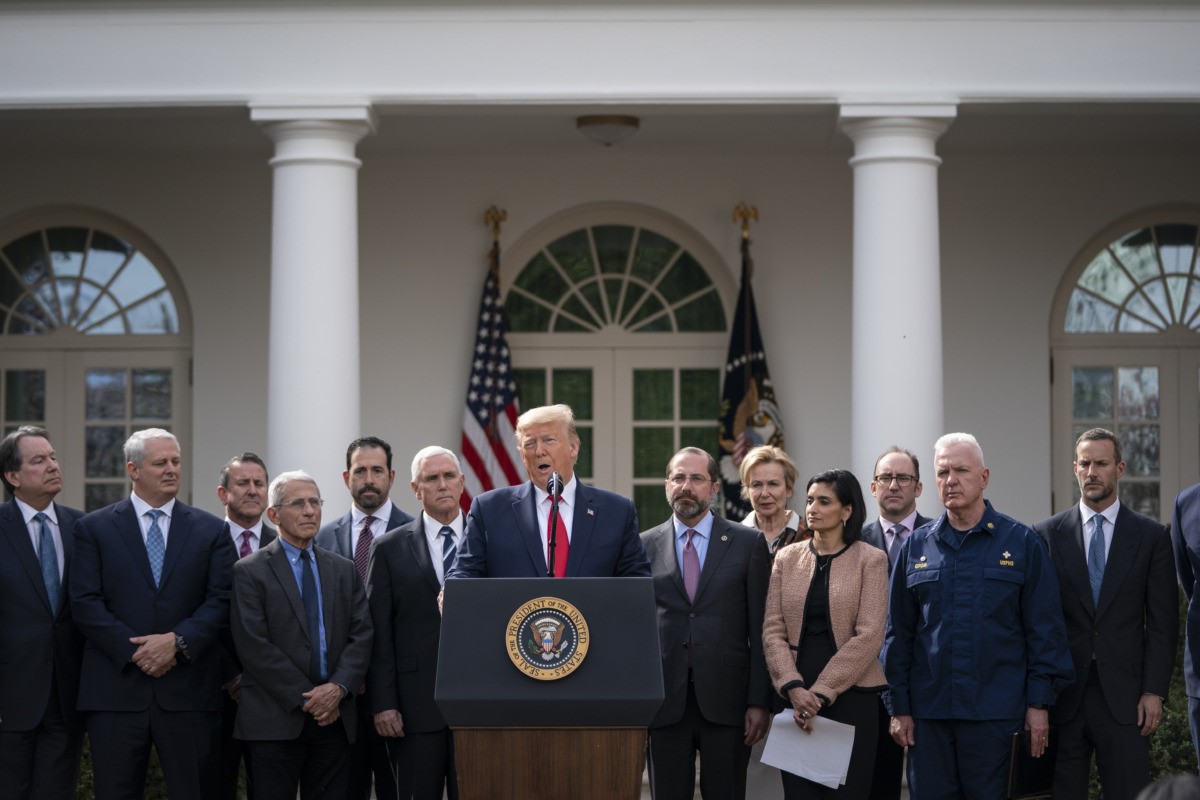
President Donald Trump holds a news conference at the White House detailing the “Whole of America” approach to defeating the coronavirus pandemic, March 13, 2020. (Drew Angerer/Getty Images)
U.S. participation in that conflict began with the Japanese sneak-attack on Pearl Harbor on December 7, 1941. Today, nearly eighty years later, many are familiar with President Franklin D. Roosevelt’s famous oration to Congress and the nation the following day, when he cited December 7 as the “date that will live in infamy.”
As FDR also said:
No matter how long it may take us to overcome this premeditated invasion, the American people in their righteous might will win through to absolute victory.
That was exactly the right tone: Win. Win at any cost.
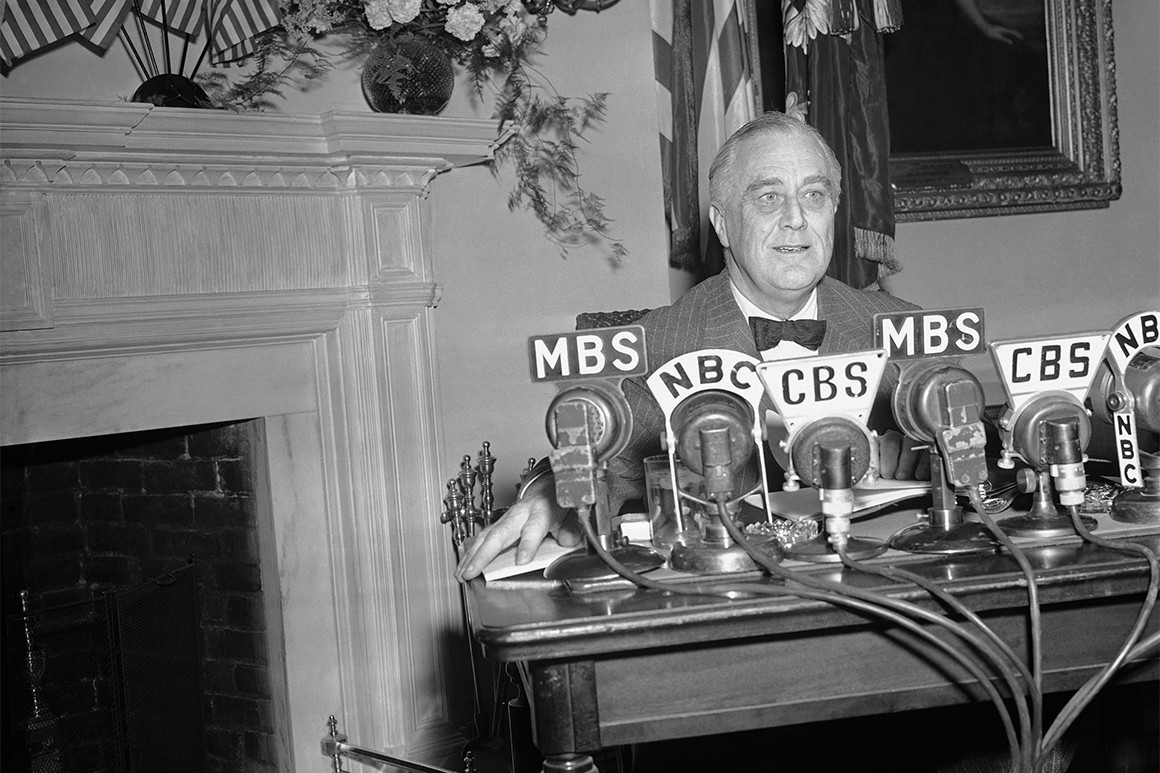
President Franklin D. Roosevelt speaks to the nation from the White House on Dec. 9, 1941, the day after the attack on Pearl Harbor. (AP Photo)
Less remembered is FDR’s “fireside chat” of December 9, 1941, carried to the nation on radio, in which the 33rd president laid out the scope for the Whole of America:
We are now in this war. We are all in it—all the way. Every single man, woman, and child is a partner in the most tremendous undertaking of our American history. We must share together the bad news and the good news, the defeats and the victories—the changing fortunes of war.
Interestingly, FDR focused on two key elements of this “partnership” approach, both of which he deemed vital. And it’s interesting, as well, to take note of the precise sequence in which he placed these two elements. First, FDR cited the proper role of the press, as well as the need to suppress rumor-mongering. Second, he cited the need to boost war-production.
Both elements offer lessons for today.
The Whole of America Then: The Press
As FDR said in that December 9, 1941, chat with the nation, what we now know as “the media” had a special responsibility:
To all newspapers and radio stations—all those who reach the eyes and ears of the American people—I say this: You have a most grave responsibility to the Nation now and for the duration of this war.
And that responsibility, of course, was not to publish rumors, enemy propaganda, or defeatism. As Roosevelt put it:
Most earnestly I urge my countrymen to reject all rumors. These ugly little hints of complete disaster fly thick and fast in wartime. They have to be examined and appraised.
As an example, FDR added:
Many rumors and reports which we now hear originate with enemy sources. For instance, today the Japanese are claiming that as a result of their one action against Hawaii they have gained naval supremacy in the Pacific. This is an old trick of propaganda which has been used innumerable times by the Nazis. The purposes of such fantastic claims are, of course, to spread fear and confusion among us, and to goad us into revealing military information which our enemies are desperately anxious to obtain.
A phase often used in those days was “fifth column.” That is, a country could be attacked by an enemy column of troops or tanks from four directions—east, north, south, west—and that was bad enough. And yet the most dangerous column was the fifth column, the enemy column from within.
FDR told America that the national government and the people should stick together and reject dangerous rumor-mongering:
Our Government will not be caught in this obvious trap—and neither will the people of the United States.
So now today, we must all be equally vigilant against rumor-mongering and panic-encouraging.
One vigilant watcher is Ari Fleischer, White House press secretary to George W. Bush. On March 13, Fleischer tweeted caustic criticism of CNN, quoting what the cable channel was saying, and then adding his own slam on the network:
“There will be a pandemic. And it will have the potential to bring humanity to its knees.” So began a promo I just saw for a show that will air on CNN. This type of promo is the kind irresponsible fear-mongering that should be avoided. CNN should change its advertising.
Fleischer is right: CNN ought to be ashamed of itself. And if it isn’t, then Americans should heap shame on the network, as a warning signal to other media outlets that might be tempted to jeopardize public order for the sake of ratings and clicks.
The Whole of America Then: War Production
The second element of FDR’s Whole American strategy was beefing up military manufacturing. In an earlier fireside chat, on December 29, 1940, the president had pledged that American forges and foundries would be the world’s “arsenal of democracy.”
And yet now, a little less than a year later, American factories would be needed, first, to equip the United States military, and second, to equip our allies around the world. As FDR put it:
I have been working today on the subject of production. Your Government has decided on two broad policies. The first is to speed up all existing production by working on a seven-day-week basis in every war industry, including the production of essential raw materials. The second policy, now being put into form, is to rush additions to the capacity of production by building more new plants, by adding to old plants, and by using the many smaller plants for war needs.
So we’re getting the picture; as this author has noted in the past here at Breitbart News, U.S. mobilization during World War Two was a wonder to behold. The wondrously huge surge in production—as FDR said, “working on a seven-day week basis . . . building more new plants”—gave us a relatively quick victory on the battlefront.
Also, interestingly, this wartime surge gave us generously overtimed prosperity on the homefront. In fact, a great many Breitbart News readers look back with pride as they recall what their grandfathers, grandmothers, and others accomplished, working line jobs at defense plants such as Michigan’s legendary Willow Run. Indeed, these many decades later, the testimony of Breitbart News readers is inspiring.

The B-24 assembly line, 1943, Willow Run Plant. (Source: The Henry Ford/Flickr)
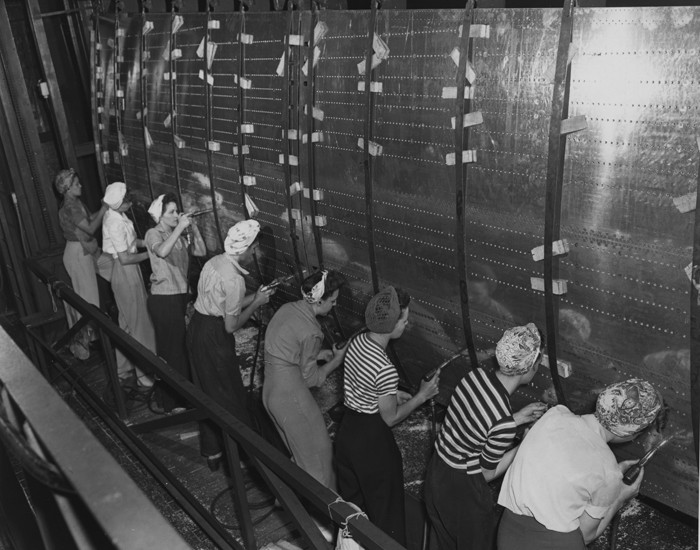
Women Riveting a B-24, 1944, Willow Run Plant (Source: The Henry Ford/Flickr)
During the war, the positive results of surging war production were evident as early as May 1942, just five months after Pearl Harbor, when the U.S. Navy won a strategic victory over the Imperial Japanese Navy at the Battle of the Coral Sea. It takes nothing away from the fortitude and heroism of our sea dogs in the Pacific to note that they were greatly bolstered by working stiffs at the shipyards and factories back home.
And the rest of the war, of course, is history—a glorious epic of the Whole of America, All In.
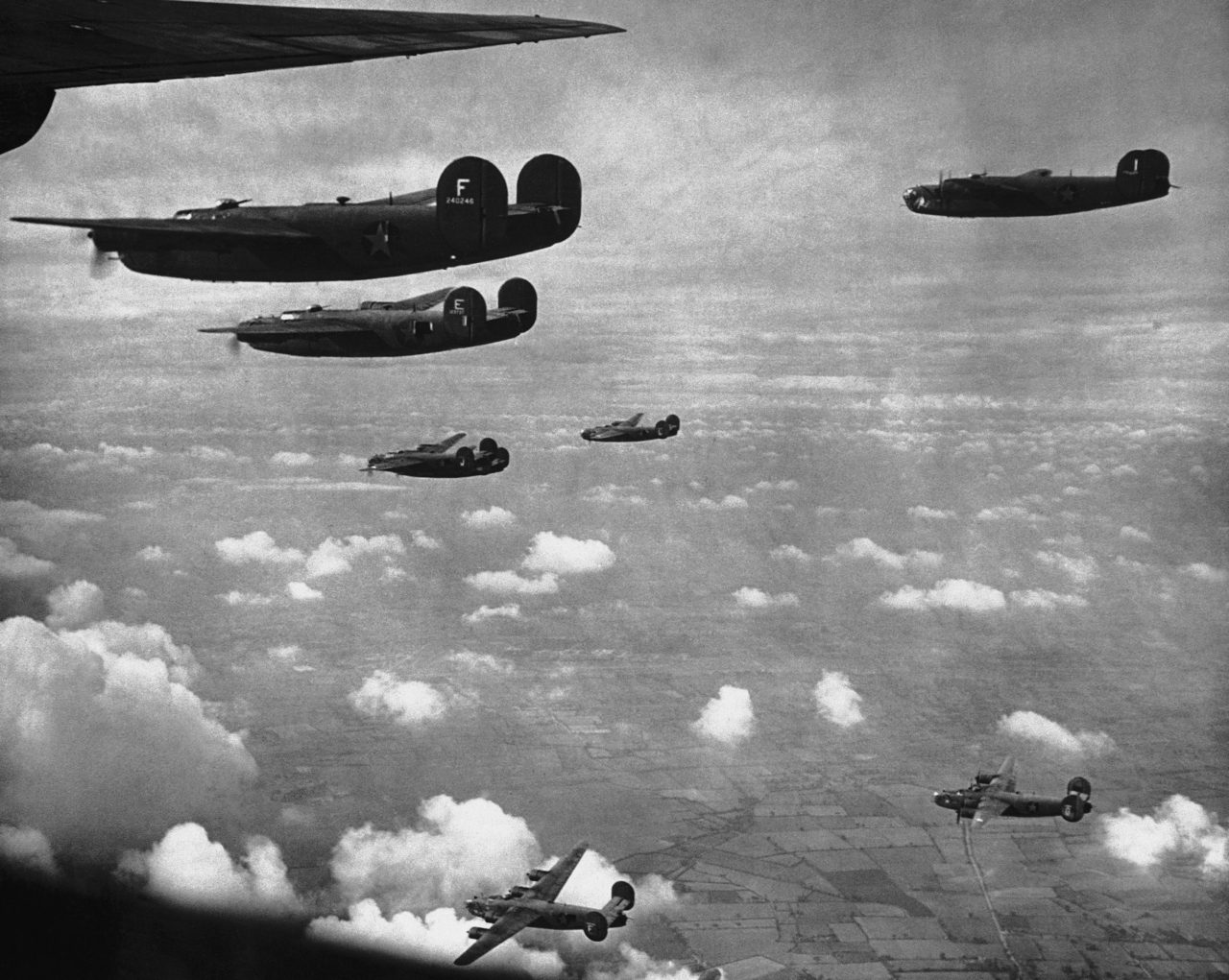
B-24 Liberator bombers of the U.S. 8th Air Force flying towards their targets in occupied Europe on Aug. 12, 1943. (AP Photo)
The Whole of America Today
In the White House Rose Garden on the 13th, Trump was generous in his praise of retailers Wal-Mart, CVS, Target, and Walgreens. He also included, and thanked, such medical firms as Thermo Risher, LabCorp, and Quest. Indeed, he even thanked Google for committing itself to building a website that would help Americans locate a corona testing center.
Such inclusion puzzled some critics of corporate America. One such is Matt Stoller, a thoughtful liberal, who tweeted:
Trump has so far thanked Google, Roche, large hospital systems, giant lab companies, and big pharma. The Trump administration does not believe in doing work, so they ask monopolists to do it for them.
In fact, Trump hasn’t always been a fan of corporate America, especially of Silicon Valley tech companies such as Google.
Yet the Whole of America Approach requires a leader to stay focused on the prime objective, which, in this instance, is defeating the coronavirus. So that can mean welcoming new allies, bringing special skills, provided that they are willing to help pull the oar.
With this new need for unity, and competence, in mind, a Silicon Valley start-up investor, Balaji S. Srinivasan, had the better point when he tweeted a response to Stoller:
This is where I disagree with Matt. The federal government has failed. CDC can’t run tests at scale. FDA doesn’t understand what an emergency is. Biopharma can manufacture drugs and vaccines, Labcorp/Quest can run tests, Google can certainly build websites. Let them get at it.
Yes, exactly: Let them get at it. Let those with the skills we need go to the front lines of production—and hopefully, it will all be made in U.S.A.
In fact, just on March 18, the Detroit News reported that General Motors and Ford are exploring ways that they can shift their auto-manufacturing capacity toward the manufacturing of breathing ventilators for severely afflicted corona patients.
We can pause to note that this is exactly the sort of home-grown can-do that we need at a time such as this. That is, we need good patriotic spirit from the business community, and we need the machinery, and the machinists, to be close at hand, within our borders, so that those industrial and human assets can be immediately repurposed for the saving of lives.
Critics will say that this sort of urgent manufacturing comes at the of inefficiency, and perhaps profiteering. And such critics have a point—but only up to a point. It’s true that doing anything hastily brings risk, but in this crisis, not acting with haste could cost many lives.
We’ll sort out everything later and assign credit (and, as needed, blame) accordingly, but first, let’s beat this virus. As they say in the Army, “The main thing is to keep the main thing the main thing.” Today, the main thing is the coronavirus.
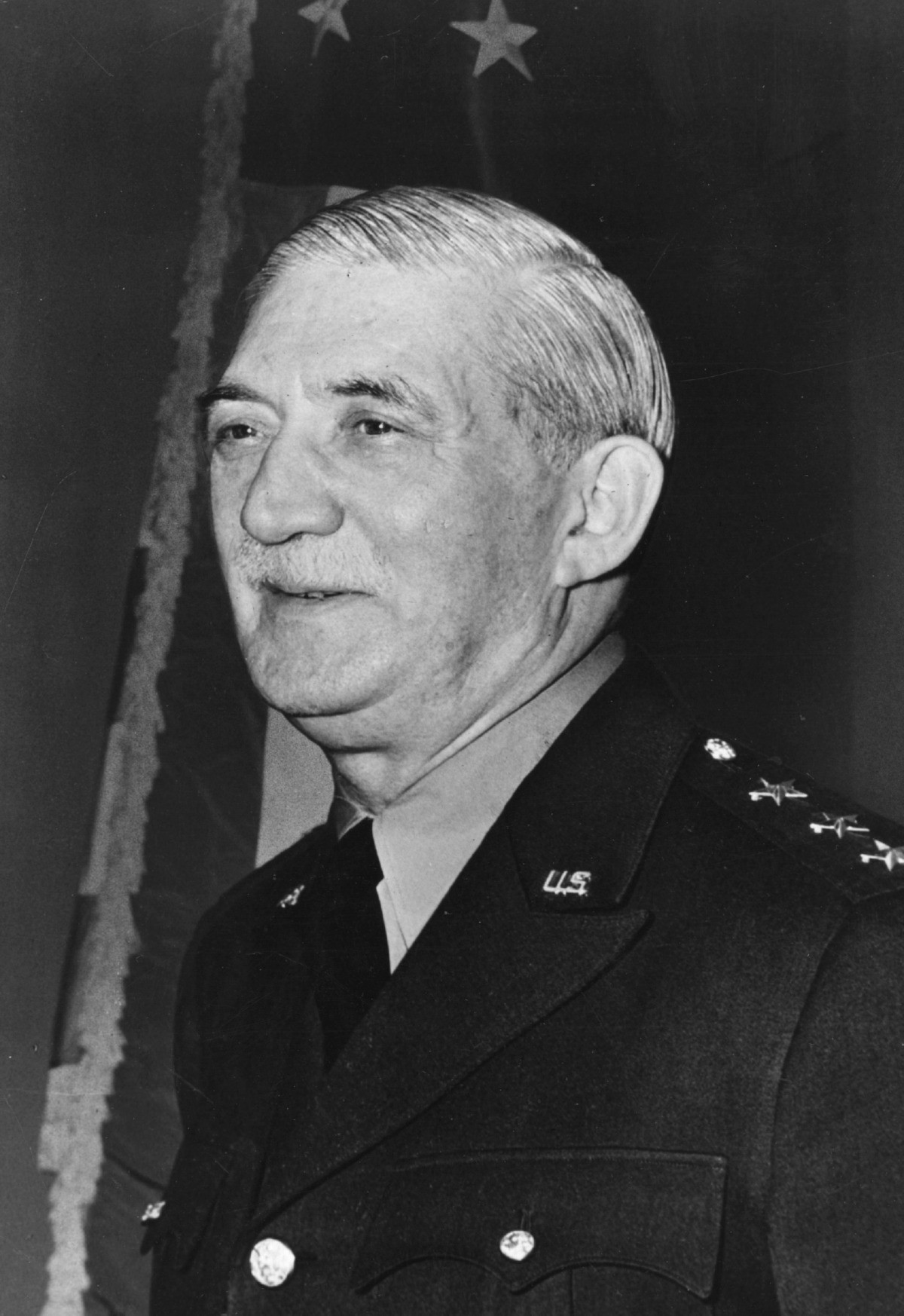
GM president William S. Knudsen, who served as Chief of Production of the Army during World War Two, circa 1942. (Hulton Archive/Getty Images)
Once again, we can look back to the helpful Whole American precedent.
During World War, FDR brought in many top business leaders to oversee war production. The most important of these was William S. Knudsen, president of General Motors, who was appointed chairman of the newly created Office of Production Management. In his government post, Knudsen worked for the princely sum of one dollar a year. In fact, in those days, there were quite a few “dollar-a-year men” in the government, applying their business skills to the challenge of ramping up defense production.
We might pause to note that FDR was not overly trusting of businessmen and corporate America. And yet at the same time, he was no socialist; he believed that the private sector was the proper hub for most production—a lesson we had learned in World War One—and furthermore, that businessmen were patriots. So he brought in the businessmen, and thus the military, as well as the country as a whole, benefited greatly from their managerial talents. (So now, today, of course, we need dollar-a-year men and dollar-a-year women.)
Yet even so, FDR was always a trust-but-verify guy. Yes, he made good use of Knudsen & Co., but that didn’t mean that General Motors, or any of the thousands of companies involved in the defense effort, were exempt from taxation and regulation.
So yes, companies were making good profits during World War Two, and yet they were paying a lot in taxes, and also, crucially, they were sharing the wealth with their workers.
The Whole of America: Workers
It’s a positive sign that Trump is working with business. As we have seen, government and business, together, can get a lot done. And yet there’s still a missing piece: labor.
That is, just as Trump met with business leaders on the 13th, he would do well to hold a similar event with American workers and their representatives, including labor union leaders.
Here again, the successes of the past should serve as a prologue for the future: On Labor Day, 1941, as the world war was gathering, but not yet on our shores, FDR said:
American labor now bears a tremendous responsibility in the winning of this most brutal, most terrible of all wars. In our factories and shops and arsenals we are building weapons on a scale great in its magnitude.
So we can see: In heaping praise on labor, Roosevelt was also pinning duty on labor. That is, workers had to actually run the arsenal of democracy, and do so with the utmost sense of relentless resolve.
Yet at the same time, FDR realized that labor had to be fully integrated into the nation, as well as the national production system. As he also said on Labor Day 1941:
The present position of labor in the United States as an interdependent unit in the life of the Nation has not come about by chance. It has been an evolutionary process of a healthy democracy at work.
Indeed, Roosevelt’s New Deal had secured the rights of labor, through such landmark pieces of legislation as the National Labor Relations Act of 1935, as well as the Fair Labor Standards Act of 1938. These bills gave labor—and labor unions—a place at the national table. And with a place at the table comes, of course, the placing of responsibility, and duty.
Labor fully stepped up. A famous war production poster from the early 40s shows how the national bargain worked. The poster depicts the rough-gloved hand of a worker shaking the well manicured hand of a businessman. And in between, the hand of Uncle Sam. The caption: “Together We Win.”
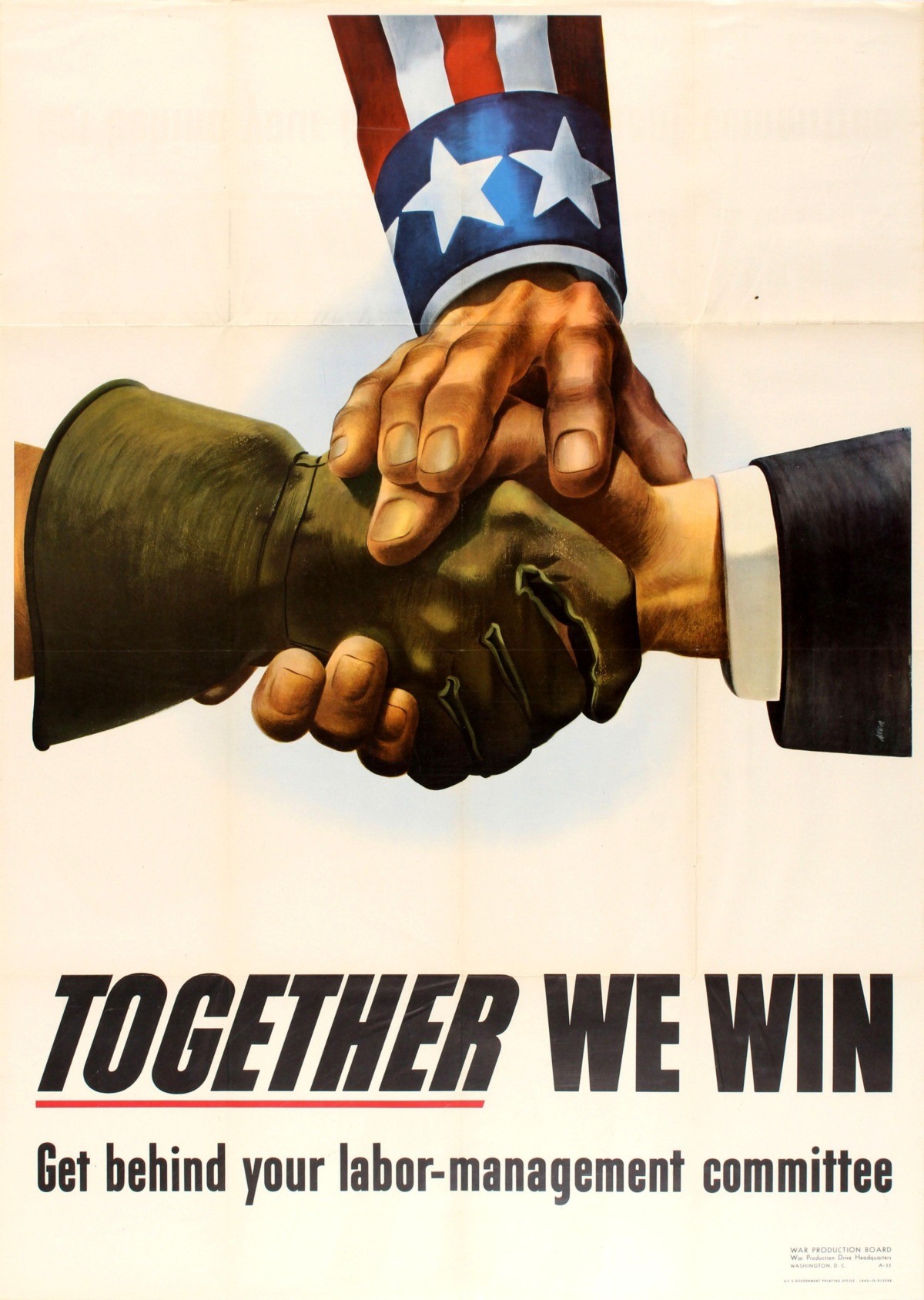
Thus it all added up to success. As FDR said in 1943, “Dr. New Deal” was being joined, now, by “Dr. Win the War.” And that’s what happened—the two doctors’ prescriptions won the war.
So today, we need government, business, and labor—working together. As top presidential adviser Jared Kushner told The Washington Post on March 19, “In America, some of our best resources are in our private sector. The federal government is not designed to solve all our problems; a lot of the muscle is in the private sector and there’s also a lot of smart people.” Again, the issue is synergies–all cooperating with all.
Putting All the Pieces Together for the Whole America
Actually, though, we need more than just the tripartite alliance of government, business and labor. We also need bipartisanship on the big things.
To be sure, nobody is under any illusions about the depths of division that the country has sunk into during the last few years, and yet now we’ve found something much worse: the medical and social threat of the coronavirus. So perhaps now that peril will force Democrats and Republicans to work together.
Thus it was interesting that on March 14, in the wake of a key next step in a bipartisan corona legislation, Trump tweeted, “Good teamwork between Republicans & Democrats as the House passes the big CoronaVirus Relief Bill. People really pulled together. Nice to see!”
We might recall that back on December 8, 1941, the declaration of war against Japan sailed through the Senate on a vote of 88:0, and the House, 418:1.
To be sure, there’s still more to be done. For instance, Trump designated Sunday, March 15, as a National Day of Prayer. As we’ve figured out by now, we need all the help we can get—and there’s no greater aid and comfort than that which can come from Providence.
And yes, there’s plenty of precedent, too, for powerful prayer. On January 1, 1942, less than a month after Pearl Harbor, FDR declared a National Day of Prayer. Indeed, there were many other occasions during the war when Roosevelt led the nation in beseeching the Almighty.
Of course, the most famous of these godly moments came on D-Day, June 6, 1944, when the president’s radio broadcast to the nation included a hymn to faithful national unity:
O Lord, give us faith. Give us faith in Thee; faith in our sons; faith in each other; faith in our united crusade. Let not the keenness of our spirit ever be dulled. Let not the impacts of temporary events, of temporal matters of but fleeting moment—let not these deter us in our unconquerable purpose.
Yes, in so many ways, the 33rd president set a high bar. He showed how the bully pulpit could elevate the spirit of the nation and guide it toward winning Whole Americanism.
So now we’ll have to see what the 45th president can do.
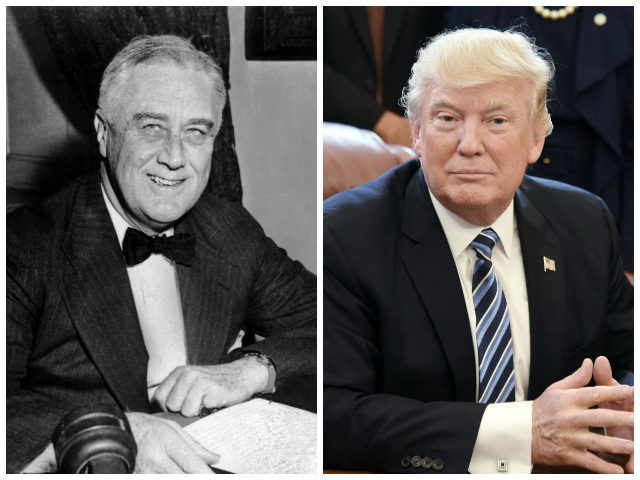
COMMENTS
Please let us know if you're having issues with commenting.